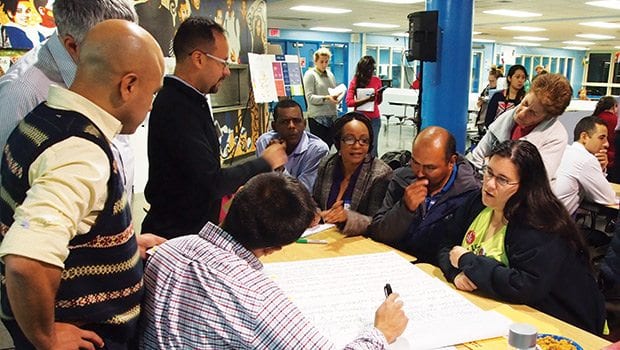
Jamaica Plain activists and Boston Redevelopment Authority representatives entered the Boston English High School cafeteria Nov. 4 with a tall order — plotting the future of a mile-long stretch of Washington Street in the face of rising rents, sky-high real estate values and an abundance of vacant and under-utilized land.
The challenges facing the area have been underscored by the contentious recent public review process around 3200 Washington Street in Egleston Square. A six-story, 76-unit apartment building is slated to go up on the site of the former Economy Plumbing and Heating Supply, a development that has sparked protests from affordable housing activists.
In April, the Boston Redevelopment Authority announced Plan: JP/Rox, its planning process for the Washington Street corridor between Jackson Square, Egleston Square and Forest Hills. BRA officials say the plan for the corridor will be incorporated into Boston 2030, the agency’s citywide planning process.
Through the Washington Street corridor planning process, residents and city officials can change zoning in the area, creating guidelines for new development. While the area currently has a mix of housing, retail and light manufacturing, new zoning regulations could dictate new allowable land uses as well as set guidelines on the height and density of new buildings.
BRA Senior Planner Marie Mercurio said the JP/Rox planning process will take nine months.

Author: Courtesy of BRAThe BRA’s Plan: JP/Rox process is looking at zoning for future development in an area between Jackson Square and Forest Hills.
“By next summer we hope new zoning amendments will be in place,” she said.
In the first meeting, held in October, residents voiced concerns about maintaining the affordability of rents, preserving affordable housing, curbing the displacement of longstanding businesses and making sure development happens in an environmentally sustainable way.
Last week at English High, several dozen community residents engaged in a brainstorming session, discussing ideas about how to maintain the economic diversity of the residents and businesses in the area.
While most of Jamaica Plain has seen widespread displacement of low-income residents, the Washington Street corridor still has a degree of income diversity, city officials noted. Of the 2,579 housing units in the area, 18 percent are income-restricted affordable rentals and 29 percent are owner-occupied. In addition, 22 percent of the renters in the area are paying more than 35 percent of their income on housing costs.
Of the 6,118 residents living in the area, 34 percent are Latino, 33 percent white, 24 percent African American and 4 percent Asian. Four percent of homeowners are elderly.
Many residents said that the area’s income mix and racial diversity could soon fall prey to displacement.
“I certainly want to see a community that supports people at different economic strata, a community that maintains the diversity — cultural and linguistic — that’s here now,” said longtime Jamaica Plain resident Alvin Shiggs. “My fear is that this will turn into what I call a middle- or upper middle-class ghetto. We need mixed-income housing. We need a place where small businesses can survive. I think we have an opportunity to do something different in Egleston Square.”
Devin Quirk, director of operations at the Department of Neighborhood Development, said the city may consider strategies to maintain income diversity, including offering income tax abatements for owners who keep their rents affordable, providing land for development corporations to build affordable housing, and a neighborhood resident preference for new affordable units.
“There are some challenges to that, but we’re looking into it,” Quirk said.
Among the incentives the city is considering to bring in more affordable housing is a provision that would allow developers to exceed height restrictions in exchange for the construction of additional floors.
Attendees broke into subgroups to discuss different aspects of development in the Washington Street corridor, including encouraging cooperatively-run businesses, rooftop urban gardening, affordable housing land trusts and programs to protect existing small businesses.
Many in the room advocated forcefully for affordable housing. Members of a coalition of groups calling for affordability for all new units in the area brought catered food to the event and distributed information packets about affordable housing.
Gabriell Paye, a member of City Life/Vida Urbana, said the pace of displacement in the Egleston Square section of Jamaica Plain is increasing.
“Every week we get five to ten new people who are losing their homes to foreclosure and eviction,” she told the Banner.
Abdul Hussein, who grew up in Jamaica Plain and now lives with his parents and siblings in Lynn, says he fears the same displacement he saw in the Hyde Square section of JP will happen in the Egleston Square area.
“It’s happening all over Boston,” he said.






